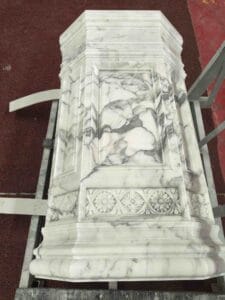Introduction
Italian Fish Belly marble—encompassing White, Gold, and Grey variants—is treasured worldwide for its ethereal appearance and enduring value. Sometimes referred to by its French influence as Poisson marbles, these stones resemble the luminous sheen of a fish’s belly under morning light. Their unique textures and colors evoke peace, luxury, and timeless elegance, making them a top choice for architects and designers globally.
In this comprehensive guide, we’ll explore:
- Origins and alternate names
- Detailed veining and color characteristics
- Applications and best use cases
- Market demand in Europe and North America
- Maintenance tips
- Answers to top Google-searched questions
- Why HRST STONE is your trusted source
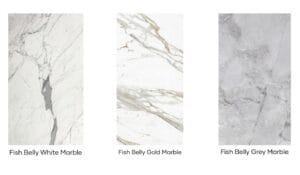
Fish Belly White Marble
Origin & Names
- Country of Origin: Italy
- Alternate Names: Bianco Poisson, White Belly Marble, Arabescato Corchia Marble, Bianco White Marble
Vein & Appearance
- Radiant, creamy white background
- Light grey or beige veining—sparse and understated
- The whiter and more consistent the slab, the higher the value
- Evokes minimalism and tranquility, ideal for elegant interiors
Applications & Best Uses
- Full-slab wall cladding in luxury foyers
- Premium staircase treads and risers
- Spa-inspired bathrooms and counters
- Designer furniture inlays or artistic surfaces
Best Practices & Precautions
- Polishing: Use high-grit polishing to enhance whiteness
- Installation: Carefully match veins across slabs for visual continuity
- Entretien: Seal thoroughly to protect against stains
- Nettoyage: Always use pH-neutral stone cleaners; avoid acid-based solutions
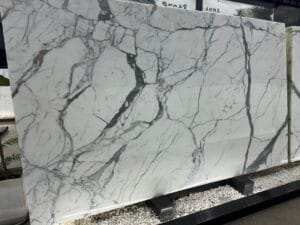
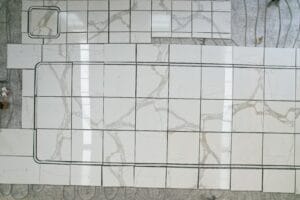
Fish Belly Gold Marble (Giallo Poisson)
Origin & Names
- Country of Origin: Italy
- Alternate Names: Giallo Poisson, Gold Vein Marble
Vein & Appearance
- Creamy to beige base with rich gold and grey netted veins
- Bold, luxurious, and full of personality
- Adds drama and refinement to any space
Applications & Best Uses
- Statement feature walls in hotel lobbies
- Dramatic staircases and risers
- Waterfall kitchen islands and vanity tops
- Accent floors in upscale residences or showrooms
Best Practices & Precautions
- Slab Matching: Align bold veins for cohesive visual flow
- Finishing: High-gloss polish accentuates natural color contrasts
- Detailing: Edges must be professionally beveled for consistency
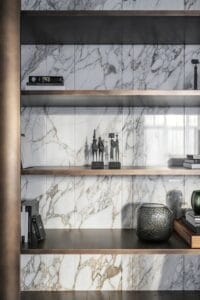
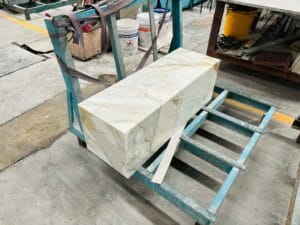
Fish Belly Grey Marble (Poisson Gris)
Origin & Names
- Country of Origin: Italy
- Alternate Names: Poisson Gris, Grey Belly Marble
Vein & Appearance
- Pale grey-white base with dramatic dark veins
- Striking contrast perfect for modern or industrial designs
- Slightly rugged, suitable for Nordic or minimalist interiors
Applications & Best Uses
- Flooring in contemporary foyers and galleries
- Façade cladding on Nordic-style architecture
- Wall panels in cultural buildings or high-end offices
- Modern staircases with sharp edges
Best Practices & Precautions
- Nettoyage: Use alkaline-based cleaners only
- Scellage: Essential, especially for outdoor or high-traffic applications
- Finishing: Brushed or honed surfaces hide wear and traffic marks better

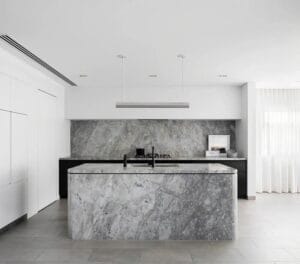
Market Popularity in Europe
Fish Belly White
- Adored in Italian villas and French country homes
- Used in restoration of classical concert halls and museums
- Frequently seen in boutique hotel suites and galleries
Fish Belly Gold
- Famed for its luxury in hospitality—especially in Spain, France, and Germany
- Featured in decorative columns and museum-style interiors
- Gold veining adds opulence to modern European villas
Fish Belly Grey
- A favorite in Scandinavian architecture
- Matches the region’s love for minimalism and contrast
- Used in large-scale cultural centers and urban residential projects
Market Popularity in North America
Fish Belly White
- Common in luxury condos and transitional homes in NYC, Miami, LA
- Used for stair treads, island tops, and polished bathroom floors
- Often paired with soft lighting and open-plan designs
Fish Belly Gold
- A showstopper in custom homes and high-end lobbies
- Popular for art-filled spaces, entrance foyers, and feature walls
Fish Belly Grey
- Often chosen for its contemporary neutrality
- Used in minimalist living rooms, bathroom showers, and garden patios
- Appeals to the sleek, monochrome trends in major U.S. cities
5 Most-Searched FAQs
1. Is Fish Belly Marble real marble or engineered stone?
It is 100% natural marble quarried in Italy, prized for its unique veining and coloring.
2. What’s the difference between Fish Belly White and Carrara White?
Fish Belly White has a creamier tone and more delicate veining, offering a warmer, softer look compared to the colder, more linear Carrara.
3. Is Fish Belly Marble suitable for kitchens?
Yes, but proper sealing and maintenance are essential due to its porous nature. Many prefer to use it on islands or backsplashes.
4. How do you maintain Fish Belly Marble?
Use pH-neutral cleaners, seal annually, and avoid acidic spills. Prompt cleaning prevents stains and etching.
5. Why is Fish Belly Gold more expensive than other varieties?
Its dramatic gold veining and rarity make it a luxury-grade material favored by designers and architects.
Why Choose HRST STONE?
HRST STONE is an industry leader in sourcing and supplying premium natural stones. With decades of experience and a global clientele, we guarantee:
- ✅ Direct quarry partnerships in Italy
- ✅ Strict quality control on every slab
- ✅ Custom finishes tailored to your needs
- ✅ On-time international delivery
- ✅ Professional installation consultation
Whether you’re designing a luxurious villa, a boutique hotel, or a statement residence, HRST STONE is your ideal partner for Fish Belly marbles.
Conclusion
Fish Belly White, Gold, and Grey marbles are more than just building materials—they’re statements of timeless elegance and artistic expression. Whether you seek serenity, bold luxury, or modern contrast, there’s a Fish Belly variety suited to elevate your project.
🌐 Explore more: www.quartzite-stone.com
📩 E-mail: assistant@hrststone.com
📱 WhatsApp: +86 13685922793

